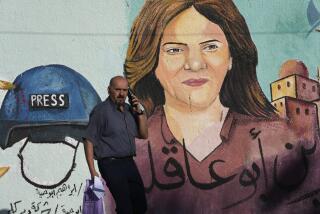Media : Starving for Information, Too : Even a makeshift newspaper is a hot ticket in Somalia, where news is hard to come by. Such publications serve as a bold proclamation of hope in the nation’s future.
MOGADISHU, Somalia — The sun had just gone down, bringing almost instant night to this city near the Equator, when a plump man in ink-smeared coveralls began fussing around a rickety duplicating machine.
In a small adjacent office, separated by a slab of cheap plywood, a Somali in his 20s scanned sheets of foolscap covered with handwriting and rapidly punched their contents into a computer. Wielding a plastic triangle, an artist beside him bent over a sheet of paper and drew a cartoon.
Another edition of Qaran (The Nation) was slowly taking shape. In this African land waking up from the simultaneous nightmares of famine, civil war and anarchy, the modest newspaper-cum-comic-strip printed in a dusty alley of Mogadishu is a brazen proclamation of hope in the future.
“Not only do we Somalis need food. We also need information badly,” the newspaper’s young founder, Omar Dini Gedi, said one evening as Qaran’s deadline loomed. “The people need to be educated. The means of teaching must be the mass media.”
A free press is an institution that has taken root with great difficulty in Africa, where governments often consider the commodity of information to be a state monopoly and the chief goal of journalists to be glorifying the supreme leader.
Qaran, in fact, is a direct beneficiary of the events that led to Somalia’s collapse: It never could have existed under the dictatorship of Mohamed Siad Barre, the Somali president who was chased from office two years ago, triggering the country’s civil strife.
And Gedi’s publication is only one of more than a dozen newsletter-size newspapers flourishing in Somalia’s anarchy. They have appeared on both sides of the Green Line that divides Mogadishu between the warlords of rival sub-clans, and other cities have their own publications as well.
A Qaran competitor is Xog-Ogaal (roughly, The One Who Knows), edited by Mohamed Aden Guled, 26, a central Somalia native nicknamed Camel’s Milk.
“The goal of this newspaper is to achieve the unity and progress of the Somali nation,” Guled said during an early morning interview. “We want all of those warlords to get out of the country.”
In a crusading editorial, Guled warned Somalis who committed crimes during this country’s two-year frenzy of destruction and murder to get ready to face trial.
The single largest publisher of all, ironically, is not Somali. It’s the 4th Psychological Operations group of the U.S. Army.
Six days a week, the army “psy-ops” experts print 20,000 copies of a two-sided sheet called Rajo (Hope), the official Somali-language voice of the multinational military coalition taking part in Operation Restore Hope.
“While we provide information, we also want to enunciate policy,” explained Maj. L.K. (Steve) Stevenson, a Special Forces officer from Colorado Springs, Colo., who is the unit’s political-military officer. “For instance, if a commander establishes a curfew, we explain the rationale.”
Rajo so dwarfs locally produced papers by its large circulation and the sophistication of its print shop--two computer-operated duplicators and a bevy of word processors--that Stevenson jokes, “We’re the national newspaper of Somalia.”
Rajo uses a comic strip with a camel and a young Somali named Elmi to get across the coalition’s message: that the U.S. Marines and other foreign forces are in Somalia to help end starvation, that people should lead the soldiers to caches of weapons, that their intention is to help and not occupy the country.
Those same messages are the theme of a Somali-language radio station run by army “psy-ops” for three hours a day.
“Our No. 1 priority here is to work ourselves out of a job,” Stevenson said.
Qaran was the brainchild of the 32-year-old Gedi, a graduate of the Somali Institute for Business, Accountancy and Management, who sports a tufted black beard and moves with the easy grace common among his East African people.
Gedi began publishing Qaran’s letter-paper-size editions of four sheets on May 19, 1991. Like Rajo, it comes out every day except Friday, the Muslim holy day.
The newspaper boasts five young reporters, plus an undetermined number of hangers-on and friends. Its correspondents attend briefings given by U.N. and U.S. officials here as well as by international aid agencies.
By shortwave radio, the Qaran staff also tunes in reports aired by the Voice of America, the British Broadcasting Corp., South African radio and Dutch radio to piece together an account of what has happened the previous day in the world and their own country.
The most important event of the day doesn’t merit a bold black headline: It is worked into a cartoon by Yerisu Rahman, Qaran’s staff artist. In a land with one of the world’s lowest literacy rates (12%, according to the latest U.N. figures), it is a clever way of making information accessible to the maximum number.
Somalia’s warlords may be turned into caricatures, along with U.S. military spokesman Col. Fred Peck or U.N. Secretary General Boutros Boutros-Ghali. Or an important episode in Somalia’s internecine strife may be depicted in a drawing, like last week’s U.S. helicopter attack on the forces of Siad Barre’s brother-in-law, yet another of the warlords.
It was in such an arty way that Qaran welcomed Operation Restore Hope itself. A cartoon showed the United Nations passively watching as Somalia suffered. After tossing Iraqi leader Saddam Hussein and Libyan strongman Col. Moammar Kadafi in jail and arresting former Panamanian President Manuel A. Noriega, a GI symbolizing the United States said to himself, “Now I’m going to Somalia.”
Qaran claims to hew to a line of strict impartiality, a downright dangerous editorial policy in a country parceled out among rival clans and sub-clans. “Yes, each faction is going to try and push us, to persuade us in its own way,” Gedi acknowledges.
He claims to keep firearms on the paper’s premises in case the persuasion turns rough. Some Somalis, however, think Qaran is in cahoots with the warlord in charge of southern Mogadishu and say they can discern a subtle bias in its coverage.
The press run, on a creaky duplicating machine, averages 2,400 or 2,500 per issue.
A flock of paperboys descend on the office every morning. They buy the newspapers for 450 to 500 Somali shillings a copy (10 to 12 cents) and sell them for double that.
When there is big news, the price goes up.
The top journalists at Qaran earn 20,000 Somali shillings a month (about $4.65). Gedi works from 9 a.m. to 9 p.m. Because electricity, like virtually all municipal services, ceased to function here long ago, a diesel generator on the roof powers the office and duplicating machine.
Rent runs 300,000 shillings (about $70) a month, and Qaran is now appealing to Somalis abroad to contribute financially to help replenish its paper stock, which is running out.
“We want to continue our efforts to teach people what the facts are, what unity is, what our economic resources are,” said Hairun Ma’ruf Hassan, 25, a Qaran reporter. “We are trying to bring people together and to start life again.”
More to Read
Sign up for Essential California
The most important California stories and recommendations in your inbox every morning.
You may occasionally receive promotional content from the Los Angeles Times.










